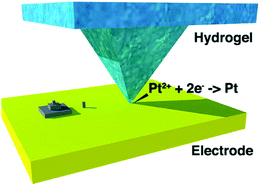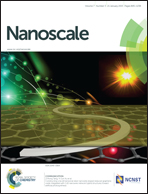A hydrogel pen for electrochemical reaction and its applications for 3D printing†
Abstract
A hydrogel pen consisting of a microscopic pyramid containing an electrolyte offers a localized electroactive area on the nanometer scale via controlled contact of the apex with a working electrode. The hydrogel pen merges the fine control of atomic force microscopy with non-linear diffusion of an ultramicroelectrode, producing a faradaic current that depends on the small electroactive area. The theoretical and experimental investigations of the mass transport behavior within the hydrogel reveal that the steady-state current from the faradaic reaction is linearly proportional to the deformed length of the hydrogel pen by contact, i.e. signal transduction of deformation to an electrochemical signal, which enables the fine control of the electroactive area in the nanometer-scale regime. Combined with electrodeposition, localized electrochemistry of the hydrogel pen results in the ability to fabricate small sizes (110 nm in diameter), tall heights (up to 30 μm), and arbitrary structures, thereby indicating an additive process in 3 dimensions by localized electrodeposition.


 Please wait while we load your content...
Please wait while we load your content...